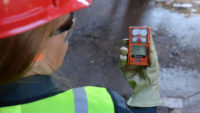Vaporized hydrogen peroxide (VHP) is a popular and efficient method of bio-decontamination. It’s used in a variety of commercial, institutional and industrial settings to decontaminate or sterilize sealed enclosures such as filling machines, barrier isolators, glove boxes and workbenches.
While the EPA has determined that VHP products registered to date have met federal standards for environmental and human health safety, it is still crucial to accurately monitor the precise concentration of this highly aggressive substance as it poses many dangers to personnel. Gas detection systems are the ideal safety solution for monitoring VHP concentration levels and ensuring the safety of crewmembers.
Introduction
The Environmental Protection Agency defines VHP as “a substance that destroys or eliminates all forms of microbial life in the inanimate environment, including all forms of vegetative bacteria, bacterial spores, fungi, fungal spores and viruses.”1 VHP is generated by actively vaporizing an aqueous hydrogen peroxide (H2O2) solution and injecting it into a room. Achieving a high level of micro-organism bio-decontamination requires a defined high VHP concentration and exposure time. However, the required high levels of VHP concentration and lengthy exposure time for bio-decontamination can present serious health hazards to personnel, especially if an unexpected leakage occurs.
VHP is nearly odorless and colorless making it extremely difficult for people to detect without a monitoring device or system. While VHP can produce a bitter taste, this only occurs at hazardous concentration levels and is therefore a poor indicator for VHP. Exposure to VHP is irritating and, at high concentration levels, corrosive to the skin, eyes, nose, throat and lungs.
Furthermore, prolonged exposure to high concentration levels can result in blisters, burns, severe eye damage and possible blindness. Even at low concentration levels, VHP exposure can cause bleaching of hair and skin.
Given the dangers of VHP exposure to humans, many countries have imposed an occupational exposure limit value. Values in the United States for both 1993-1994 ACGIH TLV and current OSHA PEL are 1 ppm (1.4 mg/m3) TWA. Staff outside a fumigated room or facility must be protected from accidental contact with H2O2 vapor. At the end of a sterilization cycle, the room or volume is rinsed with fresh air and an air analysis is necessary before it is safe for staff to enter the room or bring in new, sensitive material for a production stage. The concentration of H2O2 must be reduced through ventilation to non-hazardous levels, usually less than 1 ppm.
The generator that creates the H2O2 vapor for sterilization can also pose a risk to staff, which is why the generator’s environment and connecting hoses need to be monitored for H2O2 gas leakage.
Additionally, a risk analysis is necessary to satisfy regulatory guidelines. The purpose of the analysis is to identify all potential sources of risk, and to define measures to control exposure using gas measurement instruments, personal protection equipment and operating instructions.
Properties of VHP
VHP is a vapor – not a gas. This means that the H2O2 concentration in the air never exceeds the vapor pressure at the corresponding temperature (and pressure). Above the saturation point (dew point), H2O2 vapor starts to condense as an aerosol or on surfaces.
H2O2 is completely soluble in water. Solutions of 30% to 35% H2O2 are common for applying VHP. As vaporization of water is 15 times more effective than that of H2O2, the aqueous solution has to be actively vaporized, such as on a hot plate. When H2O2 is exposed to condensed water, the solution absorbs H2O2 and the VHP concentration in the ambient air diminishes.
H2O2 is an unstable compound. It decomposes to form oxygen and water. Thus, the concentration of H2O2 is constantly decreasing, which is why stabilizing chemicals are added to the aqueous solution. During active vaporization, these chemicals enter the fumigated room, and may condense on surfaces.
H2O2 is highly absorbent. A loss of concentration through absorption by the surrounding air and on surfaces can be observed. To saturate a surface requires a certain quantity of VHP. Thus, smaller concentrations are more heavily influenced than high concentrations. In pumped systems, the hoses adsorb H2O2 on their surfaces before it reaches the sensor and can be indicated. This loss and the accompanying delay in measurement must be taken into account. When rinsing with air, this effect extends the rinsing times of H2O2 outgassing from the surfaces.
Material compatibility
Given that H2O2 is a chemically aggressive compound that produces a highly caustic environment, reliable gas detection systems’ sensors and transmitters must be able to withstand the corrosive atmosphere. So, it’s important that any transmitters and sensors used to detect VHP are constructed with chemical-resistant materials.
If high VHP exposure will be frequent, a transmitter should be installed outside the VHP atmosphere in a way that only the sensor extends into the measurement room (remote sensing).
Leakage detection
For personal protection, workers should wear a portable gas detection device that alerts them to exposure wherever they are. For area monitoring, a stationary gas detector monitors a defined area. It is important that stationary gas detectors be placed in an ideal location to detect gas quickly and reliably. To ensure this, it is necessary to inspect and consider gas dispersion and airflow.
Safe entry measurement
A sterilization cycle for isolators or cleanrooms can be divided into four phases. The first phase in a fumigation cycle is dehumidification. During this phase, air from the target room is cycled through a dehumidifier to reduce air humidity. This takes about 20 minutes, depending on the volume of the room. In the conditioning or fumigation phase, hydrogen peroxide is actively vaporized at a pre- set injection rate and fed into the room. This takes about 30 minutes. Sterilization is sometimes also called the “dwell” phase. The VHP concentration is kept constant for a predefined duration of exposure. Additionally, pre-configured process parameters are applied during this phase. The parameters have been determined in the application validation for the required microbiological extermination rate.
Ventilation is the longest phase in the cycle (up to five hours). During this phase, VHP is no longer pumped into the room. The air is fed through a catalytic scrubber or replaced with fresh air to lower the concentration of H2O2 to a pre-defined threshold value. A gas detection system is required to confirm the concentration levels are low enough for workers to re-enter the room. Once this is determined and re-entry is safe, workers should wear a portable gas monitoring device for personal protection.
If VHP concentrations levels are above the time-weighted average (TWA) limit, then the appropriate air-purifying respirator (APR) should be worn.
The fumigation cycle, specific to each device, must be qualified and validated in compliance with Good Manufacturing Practice (GMP) rules during consignment. Chemical (CI) and biological indicators (BI) in the device or room measure the extermination rate. The programmed process parameters for VHP fumigation are derived from this.
Conclusion
Antimicrobials, such as VHP, play a big role in public health and safety. While they can help to eliminate harmful pathogens, they can also pose as a risk to workers who can be exposed to elevated, and dangerous, concentration levels. To support workplace safety, it’s important to use an advanced gas monitoring system that can monitor VHP concentrations and effectively detect leakages should they arise
Reference


